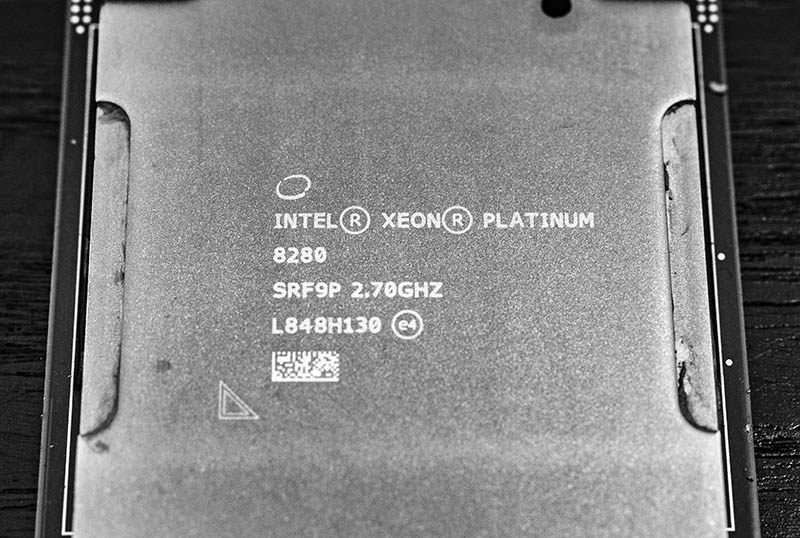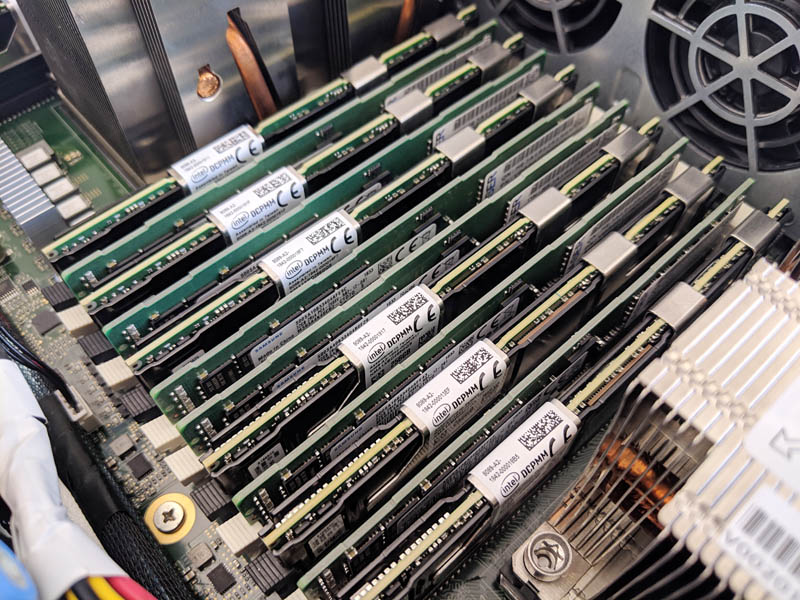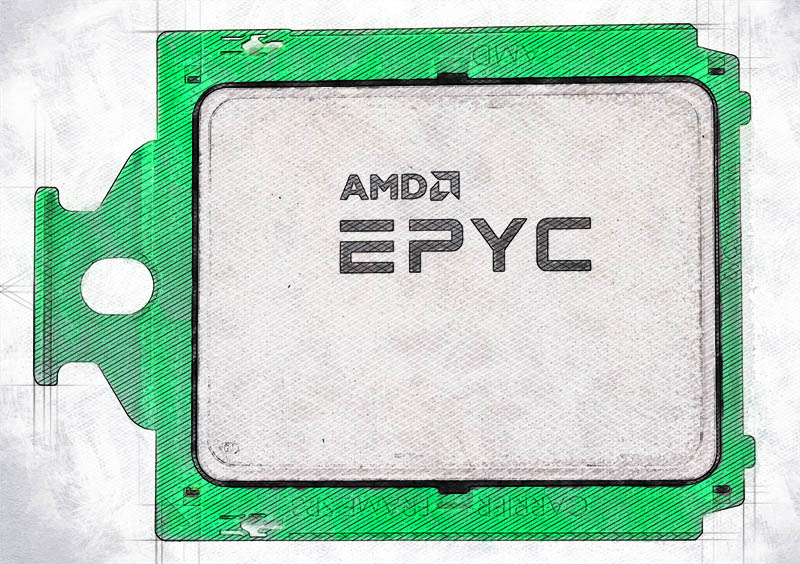Intel Xeon W-3275 Market Positioning
Thes chips are not released in a vacuum instead, they have competition on both the Intel and AMD sides. When you purchase a server and select a CPU, it is important to see the value of a platform versus its competitors.
Intel Xeon W-3275 v. Intel Alternatives
We specifically had the Intel Xeon Platinum 8280 figures in this article to do a bit of compare and contrast. Realistically, this is the closest competitor to the Intel Xeon W-3275. In some tests, we found the single-threaded performance of the Intel Xeon W-3275 to shine. If you want to do a high core count Intel Xeon single-socket server, the Intel Xeon W-3275 is a great option, with a few caveats.

The trade-off of having the UPI inter-socket link support de-featured and more PCIe lanes added, makes a lot of sense. This is something we really like from the chip, so long as your platform supports it. Some users may prefer the flexibility of a dual-socket workstation, even if that includes only one CPU at first. Also, in a dual-socket system, one can get, for example, two Intel Xeon Gold 6230 CPUs for a bit less or dual Xeon Gold 6242 CPUs for slightly more. That yields 40 lower speed cores (12 more) or 32 high-frequency cores and doubles the number of DIMM sockets while also giving up to 96 PCIe lanes. One does lose top-end single thread speed while increasing power consumption, but it is a bigger system.
If you want Intel Optane DCPMM because you have an ultra-high memory workload, or you want to access fast DIMM attached storage, then the Xeon W-3200 series is not the right option for you. Instead, get a Xeon Gold or Platinum system.

There is another elephant in the room: Intel has not been heavily pushing these chips. Even though they have a fairly unique value proposition, system vendors are saying there is less support than for the mainstream Xeon server line. As a result, the number of platforms out there supporting 64x PCIe lanes for the Intel Xeon W-3275 is far from numerous. One may not be able to find the platform they want.
New Intel Xeon W-2200 chips are out. If you are buying the Xeon W-3275 for the single-core turbo clock, or 1TB memory capacity, the Xeon W-2295 may be a better option. With the pricing of the new series, it is about a $3100 jump to get 10 additional lower speed cores ($310/ core), with two more DDR4 channels (same total capacity), and up to 16 more PCIe lanes.
With all of those adjacencies and features considered, if you still like the Intel Xeon W-3275 then it is the right chip in Intel’s stack for you.
Intel Xeon W-3275 v. AMD EPYC Alternatives
This is where things get a bit awkward. We are going to take a pass for a moment on the current AMD Ryzen Threadripper 2990WX which is the 32-core Threadripper on the market at the time of this writing. We are also going to pass on the Ryzen 3000 series that does not have the PCIe lanes, core counts, and memory configuration to compete in this segment.

Instead, we look to the AMD EPYC 7002 Series. If you are more thread count constrained than clock speed, there is a 64-core AMD EPYC 7702P at around the same price. If you want to save some money, the AMD EPYC 7402P is a solid 24-core option at around 1/3rd the cost and the AMD EPYC 7502P is a 32-core option at about half the cost of an Intel Xeon W-3275. All three options offer more memory bandwidth and capacity plus more PCIe bandwidth and connectivity. By not supporting Intel Optane DCPMM on the W-3200 series, Intel does not have that advantage here.
Instead, the choice basically comes down to a few points:
- If the AMD EPYC’s caches will be used, it is very competitive at 24 cores, and faster at 32 cores all for a lower purchase price.
- Intel has AVX-512, DL Boost (VNNI), and higher single-thread clock speed. If you need those Intel the way to go.
- Intel may not have the biggest ecosystem for the W-3200 series, but it is greater than the AMD EPYC workstation market.
- If you need more memory capacity or a lot of PCIe Gen4 lanes, the AMD EPYC is a better choice.
If Intel had pricing similar to the Xeon W-2200 series and the Xeon W-3275 was closer to $2200-$2300, this would be a much closer comparison.
Final Words
Overall, there is a lot to like here. If you are looking for a single socket workstation CPU where you can utilize a lot of memory, this is the current pinnacle. There is Intel competition from below with the new Xeon W-2295 but that is limited to 18 cores and quad-channel memory. There is competition above from dual-socket servers, but those add significant cost. AMD, as of yet, has not allowed ECC RDIMMs on their Threadripper platforms, so one makes a trade-off of clock speed for more cores, memory, and PCIe Gen4 lanes going EPYC 7002 series.
We wish Intel went the extra step differentiating with Optane DCPMM. At the same time, if you want single socket Xeon Scalable, the Xeon W-3275 offers a lot at a lower price point than the Platinum 8280.




Is it unlocked as the 3175 chip?
It is not. Intel stopped that with the Xeon W-3175X.
There is a high-memory Xeon W-3275M version if you want to use up to 2TB of RAM with it.
Yeah, I might need that, have a bit over 2Tb of memory laying around :)
In september , STH wrote: “…Adding Intel Optane DCPMM to workstations…”
Will Intel be adding Optane DCPMM support to the w-3200 series??
Definitely would a great all in one small server with quad gpus and persistent memory database!!
Dual socket Xeon Scalable workstations are getting validated with Optane and the cooling for 18W DCPMMs.
Why is the 7702P Linux kernel compile rate so much higher (~35) than in the review for that chip you guys did from a few weeks ago (~22)?
Hi Nh – the 7702P review was done on the old test setup/ firmware, but got pushed due to scheduling. In Q4, we have been re-running everything on platforms we expect to use through mid-2020. The 8280’s, for example, got 0.7% faster there as well. We are keeping everything on the same setup, but that is one that moved significantly on the higher core count AMD side. Part of that is that we are using a more mature test platform for the new results. The 7702P is ~32 on the current setup using DDR4-3200 where the 7742 is between 34-35 now as well.
That is why we keep results using the same hardware, kernel, firmware, and etc. all in the same chart and re-test everything when a change happens.
Thanks for the clarification Patrick!